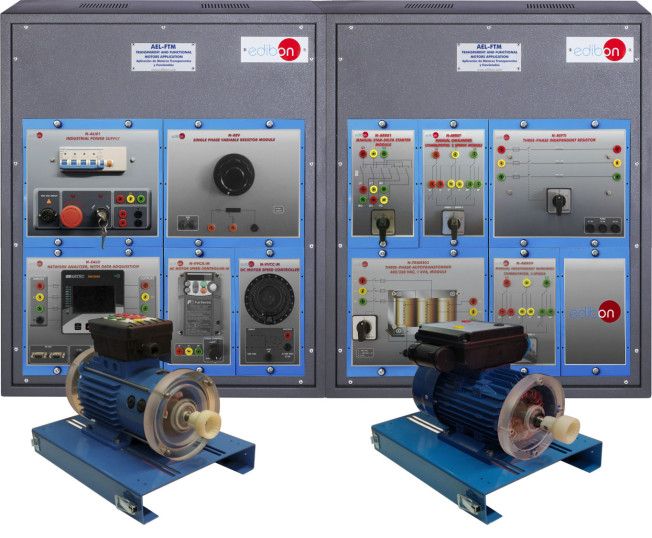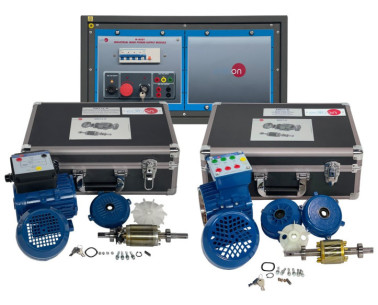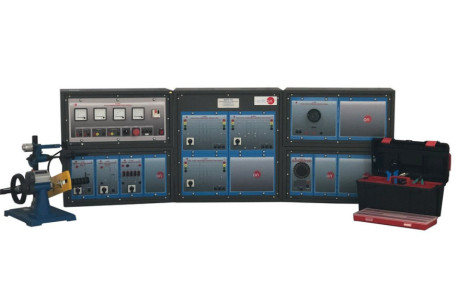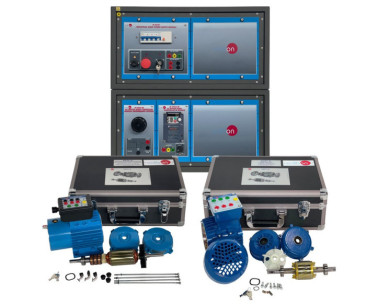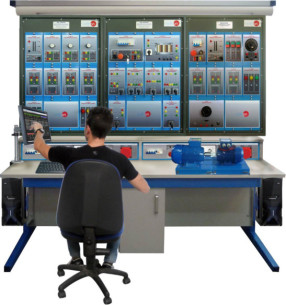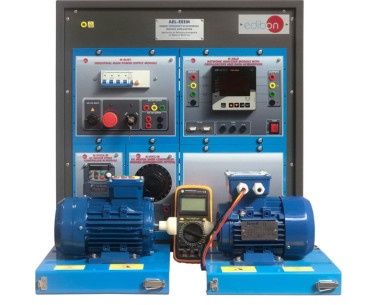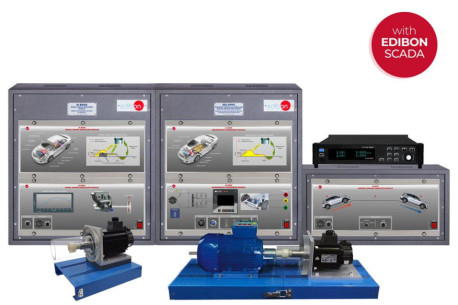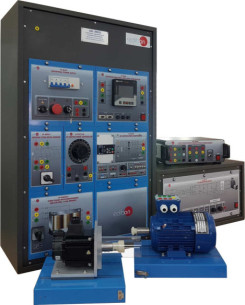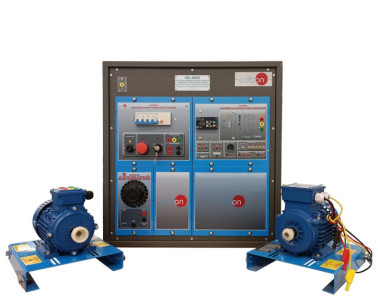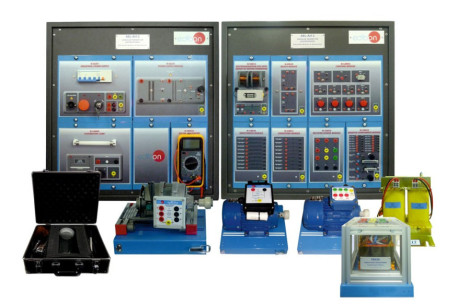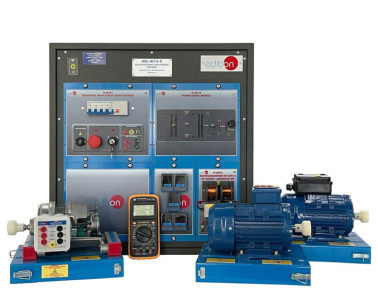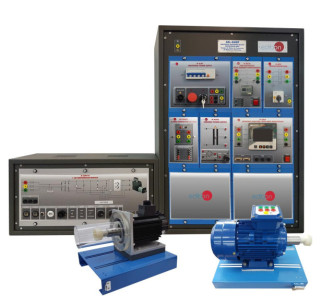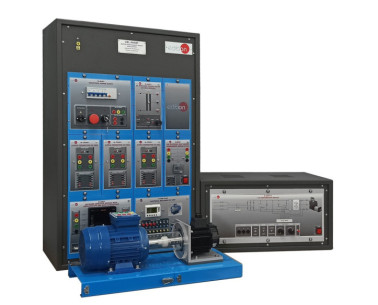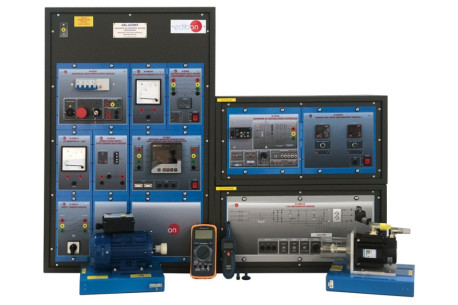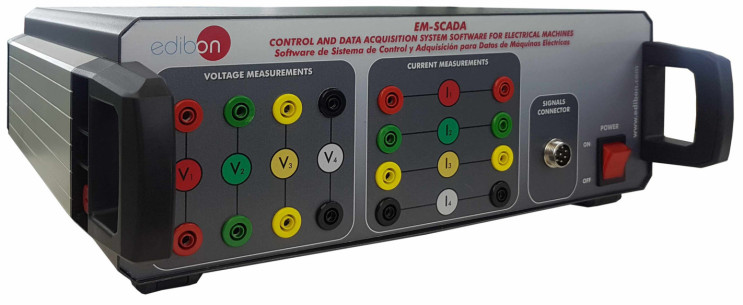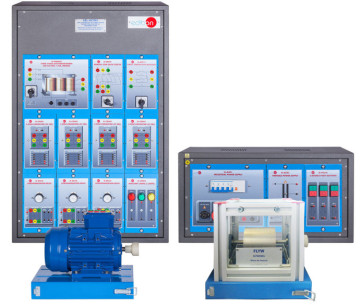The Transparent and Functional Motors Application "AEL-FTM" has been designed by Edibon for the formation at theoretical-practical and functional levels about the electric rotating machines.
This application offers several study options which will provide the user of the knowledge, at a functional level, of the electric motors. For this purpose, the application includes a specific manual explaining, at theoretical level, the relative aspects to the electric machines. The theme covers from the parts that form different types of electric machines to how their operations are. Furthermore, a set of both optional transparent motors and modules are provided for the study of the same from a practical point of view.
The AEL-FTM offers a series of optional electric transparent motors: DC Machine with Independent Excitation, DC Series Excitation Motor-Generator, DC Machine with Shunt Excitation, DC Compound Excitation Motor-Generator, DC Independent Shunt-Series-Compound Excitation Motor-Generator, AC Synchronous Three-Phase Motor Alternator, Asynchronous Three-Phase Motor of Squirrel Cage, Asynchronous Three-Phase Motor with Wound Rotor, Dahlander Three-Phase Motor, Asynchronous Three-Phase Motor of Two Independent Speeds, Asynchronous Single-Phase Motor with Starting Capacitor, Universal Motor, Permanent Magnet DC Motor, Asynchronous Single-Phase Motor with Starting and Running Capacitor, Asynchronous Three-Phase Motor of Squirrel Cage with "Y" Connection, Brushless Motor, Stepper Motor, Asynchronous Single-Phase Motor with Split Phase, Three-Phase Reluctance Motor, Single-Phase Shaded Pole Motor.
In addition, a set of modules are recommended with each electric machine in order to put into operation each one. Besides, it is possible to visualize in dynamic regime the inside of each transparent motor through the stroboscope.
One of the advantages of this application is that is included a stroboscope to visualize the rotor in operation. This technique is employed frequently in the industry to calibrate or repair the equipment. Besides, with the modules which are offered in each option, can be done speed regulation tests and in some cases to study the drop voltage produced by the loads.
The basic equipment of AEL-FTM is formed by the following modules:
• N-ALI01. Industrial Main Power Supply.
• N-MED65. Digital Multimeter. (2 units)
• STRO. Stroboscope.
Optional motors to be acquired:
Option 1: Study of DC Independent Excitation Motor-Generator.
• EMT1-T. Transparent and Functional DC Independent Excitation Motor-Generator.
• N-VVCC/M. DC Motor Speed Controller (Intermediate option). (2 units).
Option 2: Study of DC Series Excitation Motor-Generator.
• EMT2-T. Transparent and Functional DC Series Excitation Motor-Generator.
• N-VVCC/M. DC Motor Speed Controller (Intermediate option).
Option 3: Study of DC Shunt Excitation Motor-Generator.
• EMT3-T. Transparent and functional DC Shunt Excitation Motor-Generator.
• N-VVCC/M. DC Motor Speed Controller (Intermediate option).
Option 4: Study of DC Compound Excitation Motor-Generator.
• EMT4-T. Transparent and Functional DC Compound Excitation Motor-Generator.
• N-VVCC/M. DC Motor Speed Controller (Intermediate option).
Option 5: Study of all connections of DC Machines.
• EMT5-T. Transparent and Functional DC Independent Shunt-Series Compound Excitation Motor-Generator.
• N-VVCC/M. DC Motor Speed Controller (Intermediate option). (2 units)
Option 6: Study of AC Synchronous Three-Phase Motor Alternator.
• EMT6-T. Transparent and Functional AC Synchronous Three-Phase Motor Alternator.
• EMT7. Asynchronous Three-Phase Motor of Squirrel Cage
• N-VVCC/M. DC Motor Speed Controller (Intermediate option).
• N-REFT. Three-Phase Resistor Load with Commutator.
• N-VVCA/M. AC Motor Speed Controller (Intermediate option).
Option 7: Study of Asynchronous Three-Phase Motor of Squirrel Cage.
• EMT7-T. Transparent and Functional Asynchronous Three-Phase Motor of Squirrel Cage.
• N-VVCA/M. AC Motor Speed Controller (Intermediate option).
Option 8: Study of Asynchronous Three-Phase Motor with Wound Rotor.
• EMT8-T. Transparent and Functional Asynchronous Three-Phase Motor with Wound Rotor.
• N-REVT. Three-Phase Variable Resistor.
• N-VVCA/M. AC Motor Speed Controller (Intermediate option).
Option 9: Study of Dahlander Three-Phase Motor.
• EMT9-T. Transparent and Functional of Dahlander Three-Phase Motor.
• N-VVCA/M. AC Motor Speed Controller (Intermediate option).
Option 10: Study of Asynchronous Three-Phase Motor of Two Independent Speeds.
• EMT10-T. Transparent and Functional of Asynchronous Three-Phase Motor of Two Independent Speeds.
• N-VVCA/M. AC Motor Speed Controller (Intermediate option).
Option 11: Study of Asynchronous Single-Phase Motor with Starting Capacitor.
• EMT11-T. Transparent and Functional Asynchronous Single-Phase Motor with Starting Capacitor.
Option 12: Study of Universal Motor.
• EMT12-T. Transparent and Functional Universal Motor.
• N-VVCC/M. DC Motor Speed Controller (Intermediate option).
• N-REV. Variable Resistor.
Option 13: Study of Permanent Magnet DC Motor.
• EMT15-T. Transparent and Functional Permanent Magnet DC Motor.
• N-VVCC/M. DC Motor Speed Controller (Intermediate option).
Option 14: Study of Asynchronous Single-Phase Motor with Starting and Running Capacitor.
• EMT16-T. Transparent and Functional Asynchronous Single-Phase Motor with Starting and Running Capacitor.
Option 15: Study of Asynchronous Three-Phase Motor of Squirrel Cage with "Y" Connection.
• EMT17-T. Transparent and Functional Asynchronous Three-Phase Motor of Squirrel Cage with "Y" Connection.
• N-VVCA/M. AC Motor Speed Controller (Intermediate option).
Option 16: Study of Brushless Motor.
• EMT18-T. Transparent and Functional Brushless Motor.
• N-ALI03. AC Auxiliary Power Supply.
Option 17: Study of Stepper Motor.
• EMT19-T. Transparent and Functional Stepper Motor.
• N-ALI03. AC Auxiliary Power Supply.
• N-VVCC/M. DC Motor Speed Controller (Intermediate option).
Option 18: Study of Asynchronous Single-Phase Motor with Split Phase.
• EMT20-T. Transparent and Functional Asynchronous Single-Phase Motor with Split Phase.
• N-VVCA/M. AC Motor Speed Controller (Intermediate option).
Option 19: Study of Three-Phase Reluctance Motor.
• EMT21-T. Transparent and Functional Three-Phase Reluctance Motor.
• N-VVCA/M. AC Motor Speed Controller (Intermediate option).
Option 20: Study of Single-Phase Shaded Pole Motor.
• EMT22-T. Transparent and Functional Single-Phase Shaded Pole Motor.
Additional and recommended brakes to be chosen to study these motors:
• FREND. Dynamo Brake.
• DI-FRE. Pendular Dynamo Brake.
• FRECP. Eddy Current Brake. This brake requires the DC Motor Speed Controller (N-VVCC/M).
• FRENP. Magnetic Powder Brake.
• FRE-FE. Electronic Brake.
• FREPR. Prony brake.
Additional and recommended measurement module:
• N-EAL. Network Analyzer Unit.
Expansion learning software:
In addition, Edibon provides expansion learning software (AEL-FTM/ICAI) to reinforce knowledge about this field. This software is formed by:
• ECM-SOF. EDIBON Classroom Manager (Instructor Software).
• ESL-SOF. EDIBON Student Labsoft (Student Software).
The application AEL-FTM can be mounted on rack (option A) or on rail (option B):
Option A:
This application needs the following racks.
• N-RACK-M. (2 units).
Optionally the AEL-WBR. Electrical Workbench (Rack) can be supplied to place the rack/s.
Option B:
This application can be mounted on rail.
Optionally the AEL-WBC. Electrical Workbench (Rail) can be supplied to mount the modules.
 Настройки cookie
Настройки cookie

